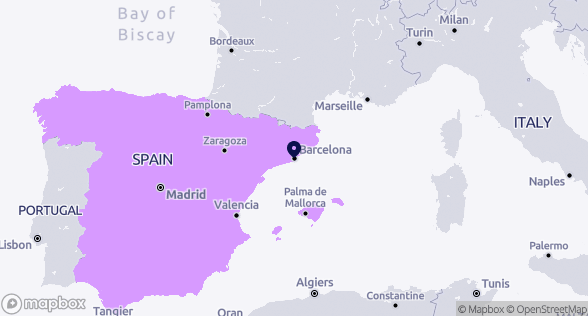
Barcelona
Spain
GBG_AS2C - Barcelona
The GBG_AS2C project’s aim has been to prepare the city for high temperatures, which, according to projections, will severely affect Barcelona both through increasing frequency of heatwaves and through the days per year that will exceed 30 degrees. Barcelona is expecting an additional 30 per year by 2030. The city estimates that 150 people a year die from heat effects. Women are twice as likely as men to be affected.
In response, the city decided to create climate shelters in 11 school buildings in the areas of the city that are the most vulnerable to the heat island effect and where adjacent green space is lacking. GBG AS2C was thus born. The project focused on schoolyards and reducing the interior temperatures inside school buildings. It is an innovative climate change adaptation plan because it converts schoolyards and school buildings with a mixture of water-based features - the blue in the title and green features, notably additional shade and greenery in the school yards. The grey is for changes to the buildings themselves, for example, painting roofs white, which can reduce interior temperatures by up to 3 degrees.
This is a case study as part of an UIA report. You can access all of the project's resources on its project collection page.
2. Barcelona and Just and Green Transitions
2.1 What are the implications for Barcelona?
Barcelona is seeking to adapt to the increasing number of days in the year when, exacerbated by the urban heat island effect, temperatures will be above the 30°C threshold. Temperatures are higher inland during the day than on the coast though at night this is reversed. By 2030, extreme temperatures will be 3.5 degrees higher, reaching up to 42.8°C. Without additional action by 2100, there will be 4 to 5 heat waves a year with 80 hot days over 30°C.
Barcelona was the first city to adopt the UN’s sustainable development goals. The GBG project flows from this, and especially from SDG 13.1, which is about increasing resilience and adaptive capacity. The target is that by 2030 100% of the population will be less than 300 metres from a climate shelter and that each district will have a water garden. Under SDG 13.3, by 2030 Barcelona will have effective tools for improving education, raising awareness, and building human institutional capacity for mitigation, adaptation, impact reduction and early warning of climate change effects.
The Barcelona Municipality’s 2030 Climate Emergency Action Plan is part of its SECAP. The plan details how heatwaves will affect the most vulnerable groups of the city’s population. It primarily aims to ‘Take care of everyone’, through targeting the people who are the most vulnerable to heat because of their socio-economic situation, age, gender, or state of health. The plan also includes provisions to carry out studies on the differential impact of the climate crisis on women and the most vulnerable groups in Barcelona, such as low-income groups, migrants and refugees. The GBG_AS2C project falls under this plan’s ‘priority 6 - climate-based urban transformation’.
GBG-AS2C’s climate shelters are also part of the Climate Shelter Network provided for in the Climate Plan 2018-2030. Previously, the Patis Oberts programme (‘Open school playgrounds’) had already identified the need to provide leisure spaces for children, young people and their families in their neighbourhoods, enhancing the educational and social resources and community life in the neighbourhood in a safe and friendly context. The Climate Plan goes further by identifying the opportunity to create spaces that can act as Climate Shelters for the entire population, in anticipation of the increase in episodes of heat waves.
Finally, as Barcelona has been selected to take part in the 100 Climate Neutral Cities programme, it might further develop its GBG approach under this programme.
2.2 What barriers has Barcelona faced implementing the just & green transition?
One barrier is a skills gap in urban planning. Climate change has become an emergency over a relatively short period and city planners have a key role to play in society’s response to it. Yet they need to be radical in integrating new technologies, new materials, and fast-evolving ideas about how urban design can help to tackle climate change and provide a healthy living environment through ‘greening’. In other words, the new planning needed also requires new knowledge, approaches and skills. As GBG and other innovative projects are showing, there are also many benefits to including the public, who increasingly yearn for a more natural city environment, into planning processes. The evidence is also that co-design is highly successful in getting urban services to match needs. This inclusivity is also new and also implies new skills.
3. How does GBG-AS2C promote the just & green transition?
The primary way that the project promotes the just transition is in its focus on schools in areas in need of shelter during heatwaves. GBG-AS2C identified these areas on the heat maps created at the time of the 2015 heat wave. These maps show where the heat island effect is most extreme. The schools were also selected on the basis of the age of local buildings, the heat index, the age of the population and the socio-economic level of the neighbourhood using, for example, average income and other indicators such as numbers of migrants.
So far, in the 11 schools of the project, 1 000 square metres of concrete has been replaced with vegetation, 74 trees have been planted, 2 213 square metres of shade have been generated, and 26 new water supply points have been added.
The project’s primary beneficiaries have been the children attending the schools and their teachers because few schools have modern ventilation and children spend much of the day in the building. Yet, inexpensive improvements can yield significant effects. For example, enabling cross-ventilation through classrooms can reduce the transmission of COVID-19. Besides the focus on children in school shelters, the 155 climate shelters opened before 2022 are aimed at the most vulnerable people in the community, especially those with chronic illnesses, and the elderly. Schoolyards are also kept open at weekends, from 15th June to 15th September, so that the wider community can use from them during the warmest months.
4. Keys to success
a. Strong political leadership
Strong political leadership on the just transition from Mayor Ada Colau and her political team led to a strong policy approach in Barcelona’s Climate Plan. Under this plan climate justice is one of four lines of action alongside mitigation, adaptation and citizen action focusing clearly on target groups and deprived neighbourhoods. The priority given by the mayor ensured that monthly meetings of the project team were well attended. They brought together people from all the relevant departments dealing with climate change, resilience, health and social rights. Mayor Ada Colau prioritises inclusion and vulnerable groups as part of the justice agenda. She is president of C40 Cities and has put inclusivity at the core of its climate policies. This is because women are more likely than men to die from exposure to heat and are more affected by energy poverty, so they need to be at the centre of the policy.
b. Reaching out to the right target groups
Participants at school level - parents, teachers and children - bought into the process because of its participative nature and because they could see the direct benefits that the project would bring. This meant that there was enthusiastic support from the schools and fruitful collaboration at school level between architects, technical staff, parents, teachers and children.
c. Integrated planning
Architects worked closely with key policy departments to deliver the project. One official remarked that in 30 years of service this was the first time he had seen such a collaboration and that this was the secret of success. This involved regular meetings between technical officers responsible for technical services and maintenance in the municipality. There was also delegation of responsibility to the teams operating at each school, which enabled a separation of strategic management and operational delivery.
d. Good clear communication with citizens and the school communities
Good clear communication with citizens and school communities about the impact of climate change on the city has been a key aspect of building support for the project. Schools could contribute to the communication strategy with their own press and media coverage of their transformed schools. The project website also linked to other relevant city projects and includes videos to illustrate the project’s method and results.
5. Scaling up and replication potential
More widely, the approach is replicable in any city in Europe affected by the urban heat island effect. All cities have schools, and most schools have playgrounds. There has been extensive interest from other cities, especially in Spain and the project has developed a scaling up plan. There is a close working relationship with the UIA OASIS project, in Paris, which has also been focusing on schoolyards as cool spaces for local communities during heatwaves. Cities wishing to copy Barcelona’s approach could easily adopt the choropleth heat map method. Some solutions are also relatively low cost and some, such as painting school roofs white, can contribute significantly to comfort levels in hot weather. They are easily to replicate.
About this resource
The Urban Innovative Actions (UIA) is a European Union initiative that provided funding to urban areas across Europe to test new and unproven solutions to urban challenges. The initiative had a total ERDF budget of €372 million for 2014-2020.
Similar content






Want to replicate this urban practice in your city?
Apply to an EUI City-to-City Exchange
Connect with a peer city who can bring you solutions and expertise and apply together to receive EUI support
More infos on EUI websiteBrowse existing Innovative Actions looking for Transfer Partners and cities willing to do a City-to-City Exchange looking for peers